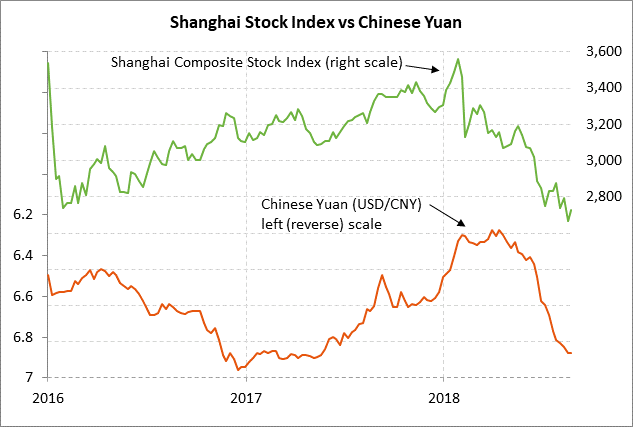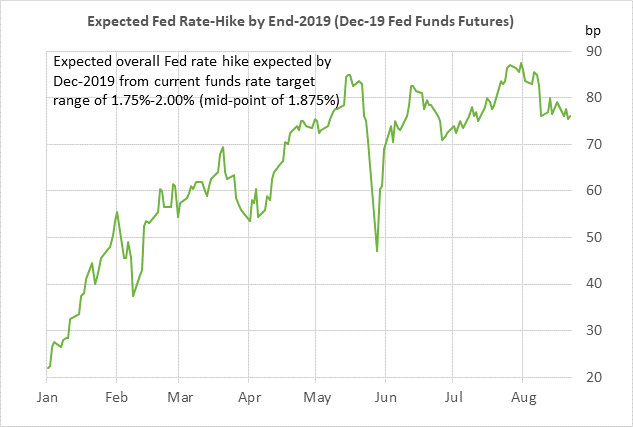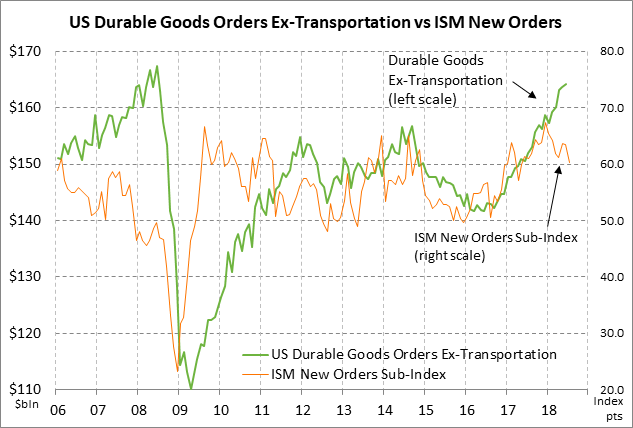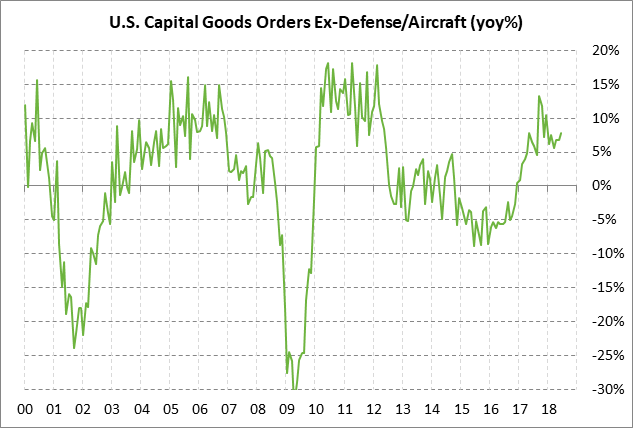- US/Chinese trade war expands to $50 billion and no progress is reported in trade talks
- Markets wait to see if Fed Chair Powell makes any consequential statements today in Jackson Hole
- Durable goods orders expected to show continued strength
US/Chinese trade war expands to $50 billion and no progress is reported in trade talks — The U.S. and China on Thursday implemented 25% tariffs on another $16 billion worth of each other’s products, bringing the total amount of products under penalty tariffs to $50 billion including July’s $34 billion of products.
The U.S. and China went ahead with Thursday’s tariffs even as they conducted their second day of mid-level trade discussions in Washington. Those talks broke up with reports of no progress and no schedule for any further talks. Reports also said that Chinese officials brought no more concessions to the talks than they were willing to give in previous talks. Perhaps even more ominous, Chinese officials reportedly wondered whether further talks might have to wait until after the U.S. November mid-term elections.
The lack of progress in this week’s talks suggest that the chances are low for averting the next round of tariffs. The Trump administration can implement 10-25% tariffs on another $200 billion worth of Chinese goods in just two weeks when the public comment period ends on Sep 6. The Chinese government has already announced that it will retaliate for that move with tariffs ranging from 5% to 25% on another $60 billion worth of U.S. products.
If the September tariff round goes into effect, then the U.S. would have a penalty tariff on $250 billion worth of Chinese goods, accounting for nearly half of U.S imports from China over the last 12 months totaling $525 billion. Meanwhile, China would have a penalty tariff on a total of $110 billion of U.S. products, representing about 80% of Chinese imports from the U.S. over the last 12 months totaling $135 billion.
There is still a glimmer of hope for a tariff cease-fire before September, perhaps in line with the model of the recent US/EU cease-fire. European Commission President Juncker in July was able to talk President Trump into a cease-fire on any new tariffs while the U.S. and EU conduct formal trade negotiations on outstanding issues. The EU had to offer only modest concessions to get that cease fire such as an agreement to buy more U.S. LNG and soybeans. The problem for China, by contrast, is that it will have to offer a much bigger up-front package of concessions to get the Trump administration to agree to a tariff cease-fire.
Regarding specific products, China’s retaliatory tariff this week on $16 billion of U.S products included 333 product categories such as coal, various petroleum and fuel products, scrap metals, recyclables, cars, buses, and many other items. China dropped crude oil off its final list so that Chinese refiners will not need to pay a tariff on oil imported from the U.S. The list contains very few agricultural products since they were already hit hard by the 25% tariff that went into effect on July 6 on $34 billion worth of U.S. products.
China’s proposed retaliation in September on another $60 billion of U.S. products would mean that China would have penalty tariffs on nearly all U.S. exports to China except for crude oil and large aircraft. China in September even plans to go ahead with a tariff on U.S. LNG exports to China. That would be damaging to the U.S. gas industry since the U.S. exported 15% of its LNG to China in 2017 and China is expected to become the world’s largest LNG importer this year.
Markets wait to see if Fed Chair Powell makes any consequential statements today in Jackson Hole — The markets will continue to closely watch developments at the 3-day Fed Jackson Hole conference that lasts through Saturday.
The headline event will be today’s speech by Fed Chair Powell titled “Monetary policy in a Changing Economy.” The markets will be watching the Jackson Hole conference for issues such as (1) the Fed’s neutral rate and how far the Fed will raise interest rates in this cycle, (2) the risks to the economy from trade tensions and the emerging markets, (3) the Fed’s ultimate balance sheet reduction goals, and (4) the outlook for wages and inflation, among many other issues.
The market is currently discounting a 100% chance of another 25 bp rate hike at the next FOMC meeting on Sep 25-26. The market is then expecting an unchanged policy at the following meeting on Nov 7-8 and then an 80% chance of the fourth rate hike of the year at the Dec 18-19 meeting.
Durable goods orders expected to show continued strength — The market consensus is for today’s July durable goods orders to show a decline of -1.0% overall but a +0.5% increase ex-transportation. That would follow June’s report of Jun +0.8% and +0.2% ex-transportation. Meanwhile, capital goods spending is expected to show strength with a +0.5% m/m increase in July capital goods orders ex-defense and ex-aircraft. That series showed a strong growth rate of +7.8% y/y in June.
U.S. durable goods orders ex-transportation were in extremely strong shape at +9.1% y/y in June as the U.S. manufacturing sector continues to see a strong influx of orders from the Jan 1 tax cuts and from general strength in the U.S. economy.
The ISM manufacturing index was strong at 58.1 in July and was only -2.7 points below February’s 14-year high of 60.8, illustrating that manufacturing executives remain very positive about the prospects for the U.S. manufacturing sector. The main factors holding back confidence are the 14-month high in the dollar, slower Chinese economic growth, and concern about tariffs. The ISM manufacturing new orders sub-index was even stronger at 60.2 in July, which illustrates that the orders pipeline for the U.S. manufacturing sector is in good shape.




